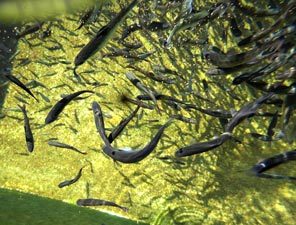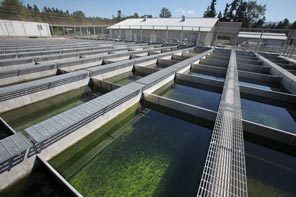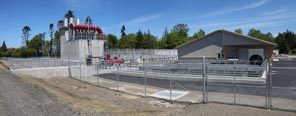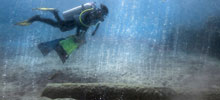Originally published August 24, 2011 at 9:21 PM | Page modified August 25, 2011 at 12:01 PM
Elwha River hatchery to hurt recovery, critics say
A $16 million hatchery will pump fish into the Elwha River after the dams come down — including nonnative steelhead — to the dismay of scientists who warn it will hurt wild fish the $325 million recovery program is supposed to help.
Seattle Times staff reporter
STEVE RINGMAN / THE SEATTLE TIMES
Hatchery-raised coho salmon are feeding at the Elwha tribal fish hatchery near Port Angeles. The fish-restoration plan for the Elwha River includes planting fish from the tribal hatchery in the middle and upper river.
STEVE RINGMAN / THE SEATTLE TIMES
Baby coho salmon are being raised at the new Elwha tribal fish hatchery. This hatchery is about three times the size of the tribe's old hatchery — which will be rendered inoperable by dam removal.
A "jump-start" for the Elwha River
Recovering salmon on the Elwha will involve more than just letting nature take its course. Fish managers are planning what they call a "jump-start" for the river, which will include planting hatchery fish. Some will be choppered upriver into the backcountry, brought in on horseback, by truck, boat and lugged on foot in backpacks.
Nonnative Chambers Creek steelhead also will be planted by the Lower Elwha Klallam Tribe in an effort to ensure a harvest for their fishermen. Releases of the Chamber Creek steelhead to the Elwha will begin in the river in May or June 2012. The fish are being grown now at the tribe's old hatchery, and will soon be moved to the new facility.
The new hatchery was completed in May and is about three times the size of the tribe's old hatchery — which will be rendered inoperable by dam removal. The tribe is negotiating with the park service sharing the cost for operation and maintenance of the hatchery, estimated at $800,000 a year. The tribe will pay the full cost of the Chambers Creek steelhead stocking program.
Source: Elwha River Fish Restoration Plan, April, 2008; staff research
![]()
You might think Elwha River recovery is going to be a simple matter of taking two dams out of a largely pristine watershed, beginning next month, and letting nature take its course. But you would be wrong.
The fish-restoration plan for the Elwha includes planting hatchery fish in the middle and upper river — fish raised at a new, $16 million hatchery built by taxpayers for the Lower Elwha Klallam Tribe as part of the recovery effort.
A nonnative run of steelhead will be planted in the Elwha by the tribe, too. Not as part of the recovery plan, but out of concern that otherwise, there won't be enough fish soon enough for tribal members to catch.
The hatchery programs are controversial. Wild-fish advocates say they are sick over the use of a hatchery on the Elwha at all, let alone the stocking of a nonnative fish. They grieve the loss of what they see as a unique opportunity to watch a wild river recover on its own.
Some, such as Jim Lichatowich, author of "Salmon Without Rivers," also see a bigger, fundamental wrongheadedness: Even using the language of "jump-start," he said, betrays a mechanistic view of what is actually a complex, resilient natural system, capable of recovery all on its own.
"The Elwha is not a dead battery," Lichatowich said.
Jack Stanford of the Flathead Lake Biological Station in Montana agreed that the Elwha and its wild fish aren't getting the respect they deserve. "Dams come out, the salmon respond. Simple as that," Stanford said.
He and other scientists note research again and again has shown hatchery fish depress the performance of wild fish. They warn that hatchery fish will hurt native runs struggling to recover — and create the rationale for keeping the hatchery going.
"If you put what I call 'zoo fish' in there to compete with those that would make new habitat their home," Stanford said, "how can that be anything but counterproductive?"
Plenty of defenders
To be sure, the hatchery has plenty of defenders. The restoration plan also states that hatchery programs should be designed to reach recovery goals, with measurable benchmarks and annual reviews to modify or curtail hatchery production according to the ecosystem's response — and avoid "operational institutionalization."
But critics warn of reluctance to ever close a hatchery — and the challenge of funding the long-term monitoring on which scrutiny of hatchery operations depends. The tribe's decision to release nonnative steelhead in the lower river also has raised grave concern, unusual in its unanimity, in scientific circles.
Scientists at every agency the tribe asked to comment on the program — from the National Park Service to the Washington Department of Fish and Wildlife to the National Marine Fisheries Service — advised against it. They argued that nonnative fish have no role to play in restoring native stocks in the Elwha; they could hurt native steelhead and interbreed with resident fish above the dams.
Genetically related to wild winter-run Washington steelhead, those trout may be a descendant of native Elwha River steelhead, locked up behind the dams like jewels in a box, waiting now more than a century for a chance to once more express their genetic capacity to go to sea as steelhead.
That flexibility to survive either as a landlocked or oceangoing fish helps them persist in the Northwest, where landslides, avalanches, volcanic eruptions and more often change the habitat for fish.
It's just that ability to take what nature throws at them that makes some scientists believe the hatchery isn't needed — and will even suppress the adaptive genius of native runs, overwhelming them before they have time to recover and thrive.
Some scientists are so concerned about hatchery fish — and especially nonnative stock — harming wild fish in the river that they would rather leave the dams in.
"There could be real genetic compromise," said Bill McMillan, a retired fish biologist and passionate wild-fish advocate. "For my part, the dams are probably better left in, protecting what remains of a wild ecosystem."
Endangered species
Will Stelle is a self-proclaimed "salmon head" who runs the Northwest Region of the National Marine Fisheries Service. A lawyer long steeped in the politics of both Washingtons, he's neither a scientist, a fisherman nor an Indian. But the work he oversees under way in the Elwha from an endangered-species perspective has had to accommodate all three.
Since construction began in 1910, Elwha Dam, five miles from the river mouth, has blocked fish passage to more than 70 miles of mainstem and tributary habitat. A second dam, Glines Canyon, also without fish passage, is 8.5 miles more upriver.
Together, they have over the course of a century so altered the river that today three runs of fish in the Elwha are listed by the federal government as threatened with extinction: chinook, steelhead and bull trout. And once the dams come down, scientists warn the river won't at first be healthy.
For about 10 years, scientists predict, the river will be carrying abnormally high sediment loads: slugs of gravel and fines that could cause fish to stop feeding, suffer gill abrasion, experience loss of fitness due to stress, and even be killed outright. The weakest runs have to be protected against extinction while the river is in transition, Stelle said. "No-brainer."
But the choice to use hatchery fish was driven by two things: the risk during dam removal of losing fish identified as unique, threatened or endangered; and the desire to see fishable runs within 20 or 30 years, according to the restoration plan.
And for the tribe, even that is too long — driving it to also continue stocking Chambers Creek steelhead, even after dam removal.
Fishing moratorium
"The problem is, we have people that are used to fishing, and they will be reducing their fishing for five years as it is," said Rob Elofson, river restoration director for the tribe, referring to a moratorium on fishing in the river, in place for five years after the dams come down.
He predicted that waiting for native runs to rebuild to fishable levels will take even longer — and if runs are too weak to support a fishery, without nonnative Chambers Creek fish raised for harvest, he said, the tribe would have nothing in the river to catch.
"If you make it another 10 or 15 years, you are talking about almost a generation," Elofson said. "We want to maintain a fishery for our tribal members," Elofson said. And not just anywhere: "On the reservation, on the Elwha," he added.
Stelle said he agrees with the tribe's decision, which also is a matter of treaty rights.
"Were treaty rights not involved and the obligation to provide for continuing fishing opportunities through this transition period not active, then we would not do Chambers Creek," Stelle said. "But those obligations are real, and they are substantial. Treaty rights are not a bumper sticker. It is a reality, and because of it we have had to reshape and modify the transition program."
Stelle said the fisheries service will watch recovery closely, to see how soon native steelhead runs could support at least tribal harvest. Tribal fishery managers say they are willing to revisit the Chambers Creek program as recovery progresses. The restoration plan also says changes to the Chambers Creek stocking plan shall be made if it appears natural colonization is hindered.
Elofson noted that the tribe has already greatly reduced the number of Chambers Creek hatchery fish it will plant, beginning in May or June 2012, to a fraction of the usual program, under way in the river for decades.
He believes concern about effects on wild fish is misplaced.
Elofson said the tribe's studies to date have found negligible effect on native steelhead, even under much higher stocking rates, in the crowded, lower five miles of the river. In an open river, he predicts less impact.
To many, the risk isn't justified. But at root, to the tribe, recovery isn't just about fish genetics. It's about fish on the table.
"The tribe wants to have fish back to the watershed that they can take advantage of," said Larry Ward, hatchery manager for the tribe.
"There is this whole philosophy of the Elwha being a living laboratory, when in reality, it is the home of the Elwha tribe. After waiting 100 years for the dams to come out, they are not willing to wait another 100 years for the fish to recover."
Lynda V. Mapes: 206-464-2736 or lmapes@seattletimes.com















